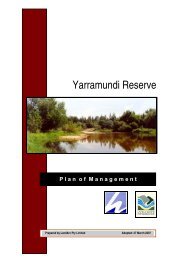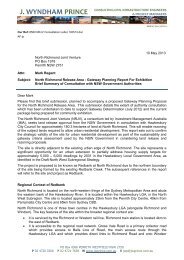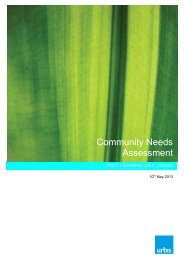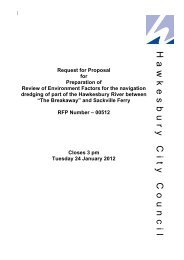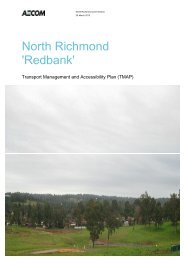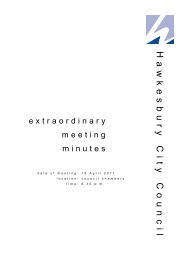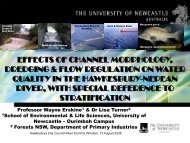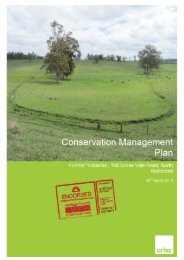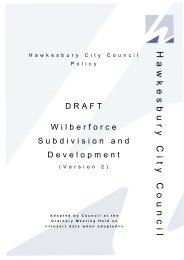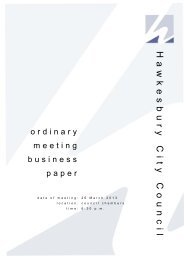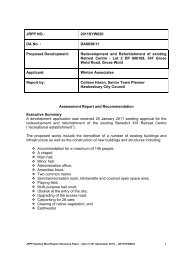Attachment 1 to Item 53 - Roadside Vegetation Management Plan
Attachment 1 to Item 53 - Roadside Vegetation Management Plan
Attachment 1 to Item 53 - Roadside Vegetation Management Plan
You also want an ePaper? Increase the reach of your titles
YUMPU automatically turns print PDFs into web optimized ePapers that Google loves.
H AW K E S B U R Y C IT Y C O U N C IL R O AD S ID E V E G E T AT IO N M AN AG E M E N T P L AN<br />
A Recovery <strong>Plan</strong> or Priority Action Statement prepared under the TSC Act may also bind Council <strong>to</strong><br />
certain actions or activities on Council owned land. The Recovery <strong>Plan</strong>s seek <strong>to</strong> involve land managers<br />
such as Council <strong>to</strong> co-operatively protect, manage and promote the recovery of the threatened species,<br />
population or ecological community.<br />
HCC’s Responsibilities in Managing <strong>Roadside</strong>s<br />
• Assess the potential environmental impacts of proposed activities;<br />
• Seek the concurrence of the Direc<strong>to</strong>r-General where significant effects are likely; and<br />
• Take all recovery plans, priority action statements, threat abatement plans and key threatening<br />
processes in<strong>to</strong> consideration when planning activities.<br />
2.2.3 NSW Fisheries <strong>Management</strong> Act 1994<br />
The NSW Fisheries <strong>Management</strong> Act 1994 (FM Act) provides for the protection, conservation and<br />
recovery of threatened species defined under the Act. It also makes provision for the management of<br />
threats <strong>to</strong> threatened species, populations and ecological communities defined under the Act, as well as<br />
the protection of fish and fish habitat in general. Community input in<strong>to</strong> management strategies for<br />
threatened species conservation is a corners<strong>to</strong>ne of the legislation.<br />
Any potential harm <strong>to</strong> marine vegetation (including mangroves and saltmarsh) requires a permit from<br />
NSW Fisheries, and if a development of activity has the potential <strong>to</strong> impact on threatened species, an<br />
assessment is required (pursuant <strong>to</strong> Part 4 or 5 of the EP&A Act). Assessments may also need <strong>to</strong><br />
consider the Department of Primary Industries (Fisheries) policies that fish passage not be obstructed.<br />
The consent or determining authority must seek the concurrence of the Direc<strong>to</strong>r-General where there is<br />
likely <strong>to</strong> be a significant effect on matters listed on the FM Act.<br />
HCC’s Responsibilities in Managing <strong>Roadside</strong>s<br />
• Assess the potential environmental impacts of proposed activities;<br />
• Seek the concurrence of the Direc<strong>to</strong>r-General where significant effects are likely; and<br />
• Take all recovery plans, habitat protection plans and threat abatement plans in<strong>to</strong> consideration<br />
when planning activities.<br />
2.2.4 NSW Protection of the Environment Operations Act 1997 No. 156<br />
The key objectives of the NSW Protection of the Environment Operations Act 1997 (POEO Act) are <strong>to</strong><br />
protect, res<strong>to</strong>re and enhance the quality of the environment in NSW, having regard <strong>to</strong> the need <strong>to</strong><br />
maintain ecologically sustainable development, and <strong>to</strong> reduce risks <strong>to</strong> human health and prevent the<br />
degradation of the environment. The POEO Act replaces previous controls in the Clean Air Act 1961,<br />
Clean Waters Act 1971, Environmental Offences and Penalties Act 1989, Noise Control Act 1975,<br />
Pollution Control Act 1970, and Waste Minimisation and <strong>Management</strong> Act 1995.<br />
The POEO Act was previously administered by the NSW Environmental Protection Authority (EPA),<br />
now part of the NSW Department of Environment, Climate Change, and Water (DECCW). It provides a<br />
single licensing arrangement <strong>to</strong> replace the different licences and approvals under existing separate<br />
Acts relating <strong>to</strong> air pollution, water pollution, noise pollution and waste management. The POEO Act<br />
© E C O L O G I C AL AU S T R AL I A P T Y L T D<br />
10



